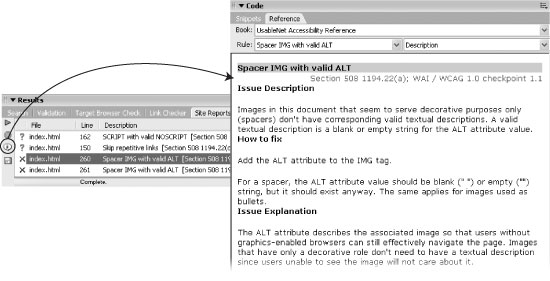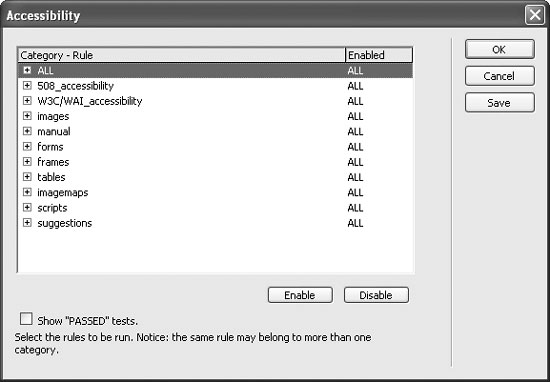| Even the clearest, most well-planned Web sites can pose a real challenge to people with vision problems. Likewise, people with motor skill problems may be unable to use a mouse and must rely on keyboard shortcuts to navigate a Web page. To make Web sites more accessible to those with a variety of disabilities , the Web Accessibility Initiative (WAI) ”a part of the World Wide Web Consortium ”has proposed guidelines for the design of Web sites. In fact, the U.S. government has mandated its own set of guidelines (Section 508 of the U.S. Rehabilitation Act) for all Web sites built by and for the government. Some states have even more stringent guidelines, and countries throughout the world are in the process of developing similar requirements. Following the WAI guidelines will improve your site by making it accessible to a larger audience. Dreamweaver MX 2004 provides several tools for meeting these guidelines and helping Web designers build more accessible sites (Section 5.2.1). But for comprehensive analysis of your site, use the Accessibility site report. With it, you can evaluate your Web pages to make sure they comply with W3C guidelines and the requirements of Section 508. Checking your site against accessibility standards is similar to running any other report. Follow steps 1-4 in Section 15.6, taking care to turn on the Accessibility checkbox. Once the report is complete ”which may take awhile for an entire site ”the process of identifying and fixing the errors is a little different than with other reports . -
Select an error in the Results panel (see Figure 15-14). Accessibility errors come with one of two designations: Failed and Manual . A failure ( marked by a red X in the Results panel) indicates that some item on the page fails to meet one of the prescribed guidelines. The most common failure is missing Alt text for graphics. "Manual" errors are those that Dreamweaver's not sure about. Check them manually and make corrections, if you deem them necessary. In both cases, fixing the problems is up to you; Dreamweaver doesn't do any auto-fixing here.  | You can set up the Insert Image command to help you with missing Alt tags; see Section 5.2.2. In addition, you'll find some guidance in the new accessibility guide built into the Reference panel (Section 10.5). | |
-
Click the More Information (i) button in the Results panel. The Reference panel shows a description of the problem and techniques for fixing it (see Figure 15-14). The UsableNet Accessibility Reference provides diagnosis and recommendations for all accessibility problems encountered by Dreamweaver's Accessibility reporting command.  -
Double-click the name of the file in the Results panel. As with other reports, Dreamweaver opens the file and automatically highlights the offending code. You can then make the recommended changes and save the page. 15.7.1 Accessibility Priorities As you'll quickly learn, there are a lot of different guidelines for creating accessible sites. The whole issue can be confusing (some helpful resources are listed in the box below). UP TO SPEED
Making Accessible Web Sites Building Web sites that meet everyone's requirements can be daunting. Unless you have screen-reader software to simulate the experience of a visually impaired visitor, or a crew of people with a variety of impairments (from color -blindness to repetitive stress injury ), to test your site, how do you know what it takes to build a fully accessible Web site? Fortunately, there are plenty of resources to get you started. The best place to start is at the Web Accessibility Initiative's Web site, especially their accessibility resources page: www.w3.org/WAI/Resources/ . Here you'll find lots of information, including examples of different disabilities some Web surfers face, plus tips, checklists and techniques for making sites accessible. And if you do want to see how screen readers work with your site, you can download a demo of JAWS, one of the most popular screen readers, at www.freedomscientific.com/fs_downloads/jaws.asp . Finally, Macromedia dedicates an entire section of its site to accessibility issues: www.macromedia.com/macromedia/accessibility/ . Here, you'll find explanations of the issues, tips for using Macromedia products, and a showcase of accessible Web sites. |
To get you started, here are a few of the priority items recommended by the WAI: -
Images, animations. Use the Alt property to describe the function of each visual element on a page (Section 5.2.2). -
Image maps. Provide Alt descriptions for each link in an image map (Section 5.4). -
Hypertext links. Use understandable text for all links. Try reading it aloud to make sure the text clearly indicates where the link goes. Avoid "click here" links. -
Organizing page content. Use headings, lists, and consistent structure. Avoid the <font> tag; instead use Cascading Style Sheets for text styling. -
Graphs, charts . Summarize information contained in informational graphics. -
Scripts, applets, plug-ins. Provide alternative content, in case active features are inaccessible or unsupported. -
Frames . Use the noframes element (Section 9.2.1) and title each frame page. 15.7.2 Accessibility Options Dreamweaver's accessibility report covers all the WAI recommendations and Section 508 requirements. This thoroughness is commendable, but it may be more than you need. By all means, pare down the report to include just the guidelines that apply to your site. To do so, choose Site  Reports and turn on the Accessibility box. Click the Report Options button to open the window shown in Figure 15-15. Reports and turn on the Accessibility box. Click the Report Options button to open the window shown in Figure 15-15. The Accessibility options window lets you control which rules Dreamweaver uses to evaluate a Web site's accessibility. You may want to fine-tune this list based on recommendations in this book or from the online sources mentioned in the box in Section 15.7.1.  You can disable any rules Dreamweaver uses to evaluate your pages. To turn off an entire category ”forms, frames, or tables, for example ”click the name and click Disable. If you'd like to get more specific, click the + button next to a category name to expand a list of individual rules for that category. You can select and disable one or more rules. For example, if your site doesn't use frames (Chapter 9), you'll save time and Dreamweaver's energy by turning off the frames category. |